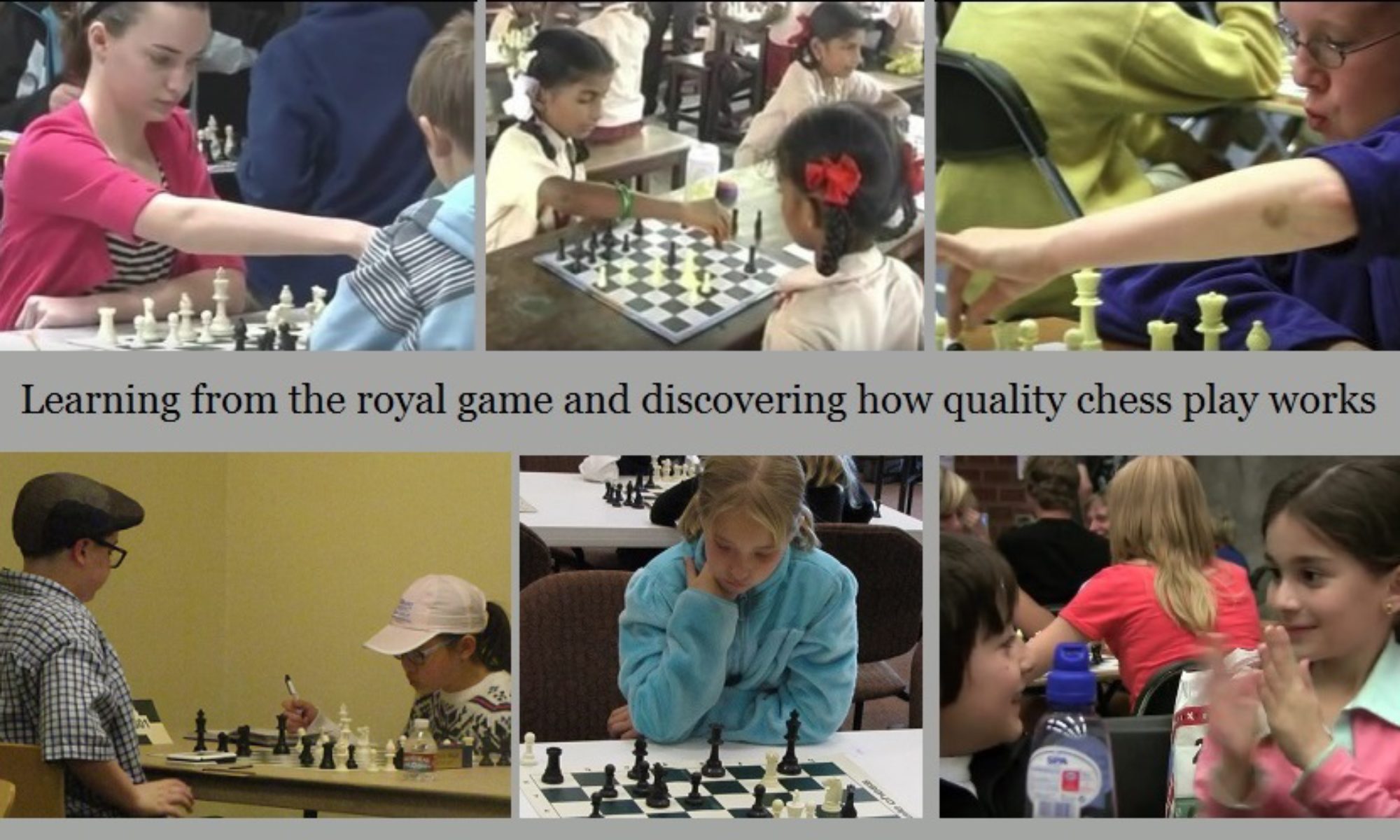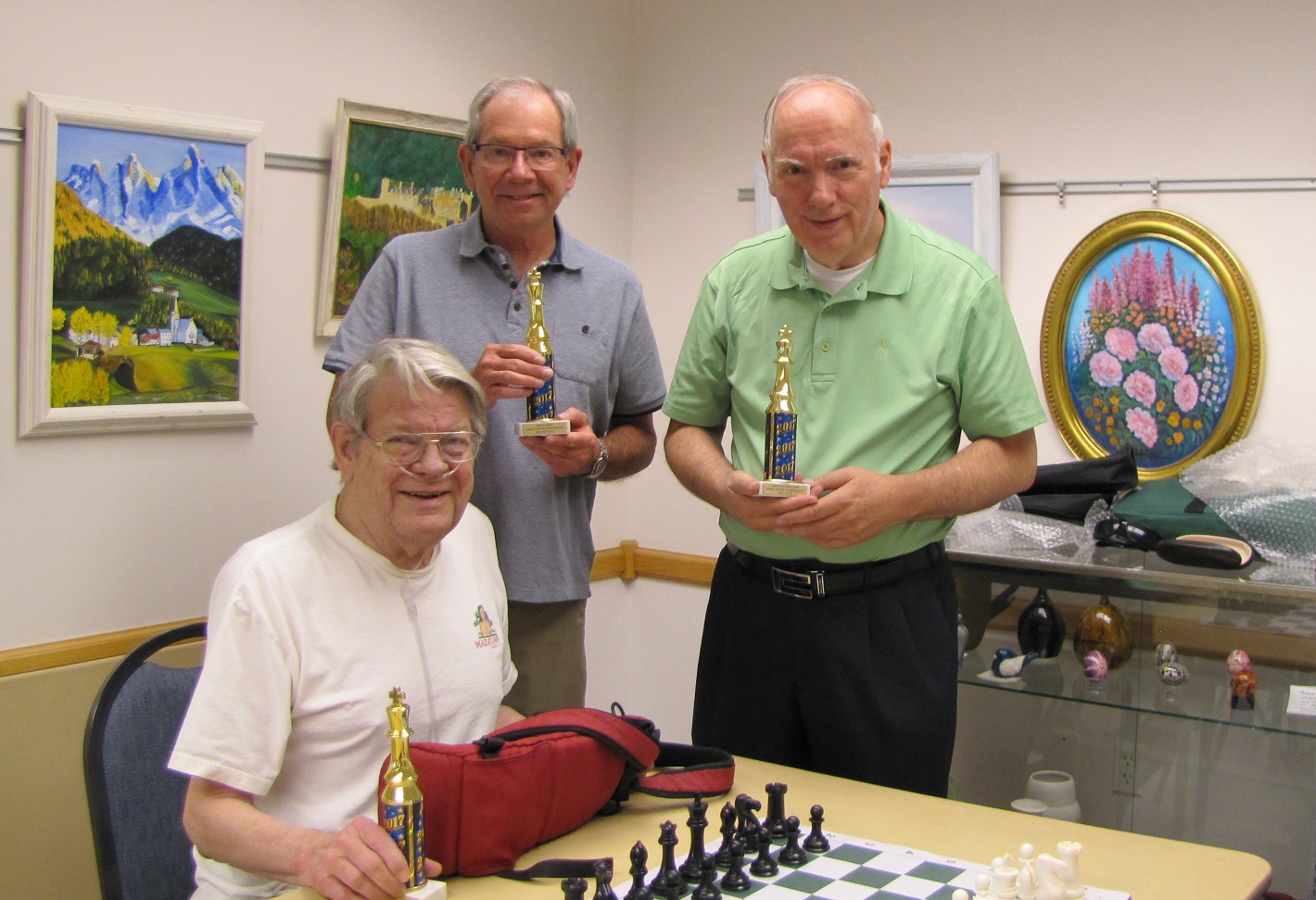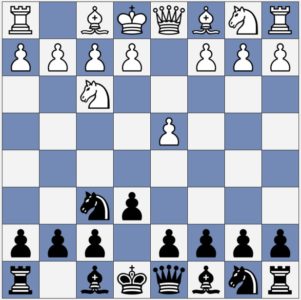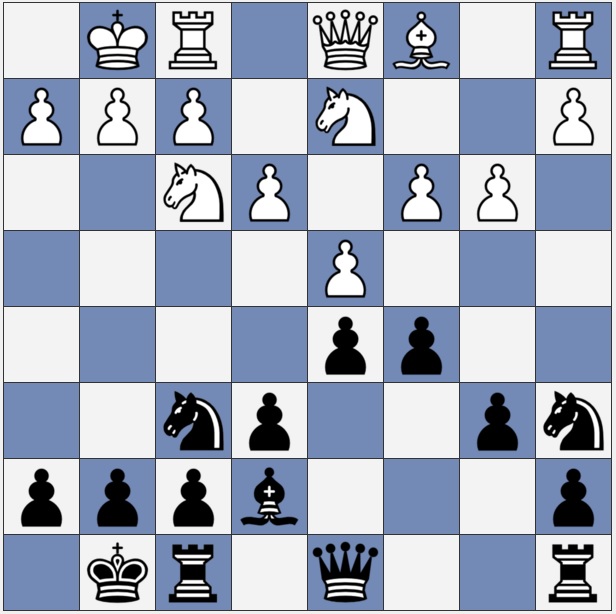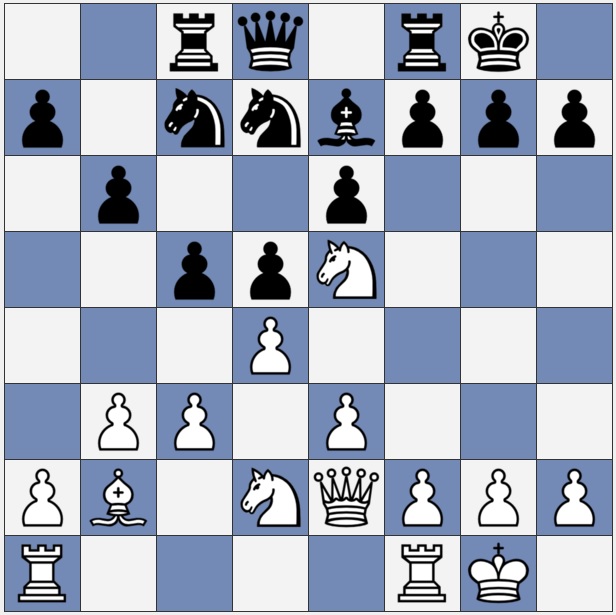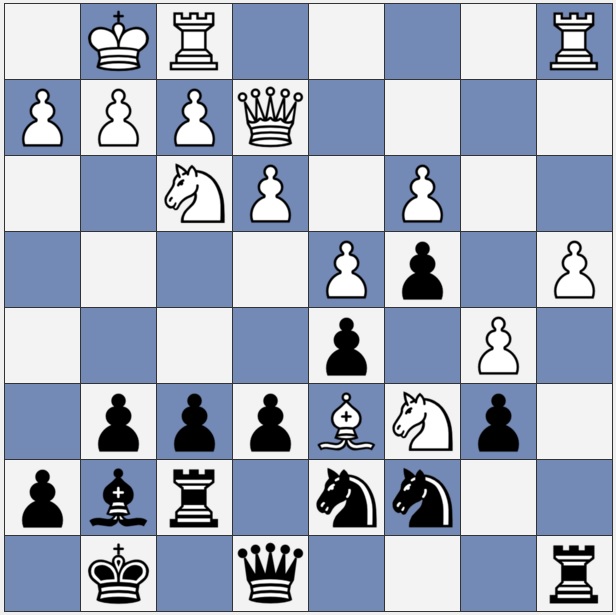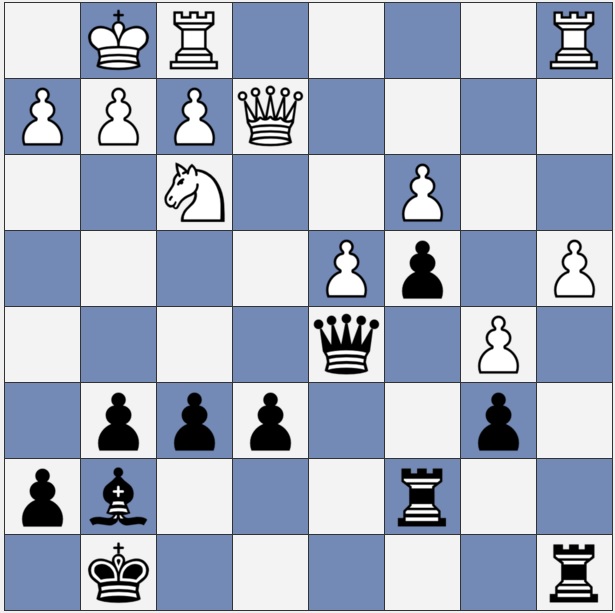By the chess tutor Jonathan Whitcomb
I’m a member of two chess clubs in the Salt Lake Valley of Utah, both of them in senior centers. Sooner or later, children who play chess, even the most talented young competitors, will probably find themselves across the board from those who have played the royal game for a long time. Keep calm and play the kind of chess you feel comfortable with. Even if your opponent has played this game since before your parents were born, he or she may have forgotten much of what was learned over those decades. And an old timer is quite capable of falling into an oversight, so keep alert for an opportunity to jump on your opponent’s blunder.
Before getting into a game that was played at the Sandy Senior center (south of Salt Lake City, Utah) in February of 2018, let me introduce myself. I teach private chess lessons, mostly in the Salt Lake Valley and mostly to children. Sometimes I teach two or more students at a time, and sometimes parents will listen and learn. I generally charge $25 per one-hour lesson, although the first session is free: a getting-acquainted lesson.
The following game was played between two of the higher-rated players of the Sandy chess club, which meets at a recreation and cultural center for senior citizens. White was rated 1615 and Black was 1855, but this is by the UCER system of rating: used by some chess players in Utah and similar to the national rating system of the United States Chess Federation.
At the time this game was played, the senior who play Black usually made at least one oversight per game, although not all of the mistakes were serious blunders. He had a knack, however, for defending difficult positions well, and this was critical to the final outcome of this contest. Since the black side eventually wins, we’ll mostly look at diagram’s from the Black perspective.
1) d4 Nf6
2) Nf3 e6
.
Diagram 1: Contrast early in the opening
After the first two moves, White controls the two dark squares in the center, Black controls the two white ones. The battle for the center, however, has only just begun.
3) e3 c5 White begins to consolidate control of d4 while Black attacks it.
4) c3 Be7
5) Bd3 d5 Now both sides are trying to control the e4 square.
6) O-O O-O
7) b3 b6 Both sides need to develop the queen’s bishop.
8) Nbd2 Ba6
Black solves one problem but creates another one. White appears to be setting up the Colle Opening system that includes a pawn break with e4. This can result in White’s light-colored bishop taking an important part in a kingside attack against Black. The eighth move by Black eliminates this white bishop but puts Black’s queenside knight in an awkward position. It will take quite a few moves for that knight to obtain a good square, if it ever does.
9) Bxa6 Nxa6
.
Diagram 2
10) Bb2 Rc8
11) Qe2 . . . . . This develops the queen and attacks that black knight.
Looking at the position objectively, that black knight should probably take two moves to reposition itself to c6. The player with the black pieces, however, may have tried to justify that knight’s original move to a6: That appears to be a mistake: The next move, Nc7, is not best for Black, although there’s no loss of material or obvious serious consequence to the knight’s new square at c7.
11) . . . . Nc7
12) Ne5 Nd7? The first significant blunder of the game.
.
Diagram 3: (From White’s perspective) what move should White make?
Did you notice that Black has a weak square, at least temporarily. In addition, White can take advantage of that weakness by using a common tactic. In this case, it wins a pawn:
13) Nc6 . . . . . This knight attacks both the black queen and a black pawn.
Black must move his queen, even though it means losing a pawn.
13) . . . . Qe8
14) Nxa7 Ra8
15) Nc6 Bf6 Black hopes to somehow trap that knight.
16) Nf3 g6
17) a4 Bg7 Black hopes that a pawn move, f6, might trap the knight.
18) Ba3 f6
19) b4? . . . . Now White blunders, losing a pawn. Black should move Rxa4.
19) . . . . c4?
20) b5 Rf7
21) Bd6 . . . .
.
Diagram-4: Black needs to protect the knight at c7.
A less-experienced player might look for a way to defend that knight (at c7) by moving over a piece to defend it: Qc1 or Rc1. After all, the knight at c7 has no safe square to move to. Black finds a way to accomplish two things, however, with one move.
21) . . . . Nb8
This allows the rook at f7 to protect that knight from capture by the black bishop and it also dislodges the white knight at c6.
22) Nxb8 Qxb8
23) e4 Qd8
24) Bxc7 Rxc7
25) Rxe5 Qxd5
.
Diagram-5: White is one pawn ahead in this chess middle game
How can White take advantage of his extra pawn? It’s not clear how to proceed, for the a-pawn is backward, held in place by the black pawn at b6 and the rook at a8.
26) Rfe1 Kf7 (protecting the pawn but also preparing for later king activity)
27) Qe4 Rca7 This is probably best, threatening White’s a-pawn.
28) Qc2 Qd7
29) Nd2 Qd5
30) Reb1 Bf8
31) Qe4? . . . . This move loses a pawn.
31) . . . . Qxe4
32) Nxe4 Rxa4
33) Rxa4 Rxa4
34) g3 Be7
Black’s idea is to drive back the knight and bring the black king up to d5.
35) h4 h5
36) Nd2 Ke8
37) Kg2 f5
Black has now achieved a balance: Many black pawns control light squares and the bishop has access to some dark squares.
.
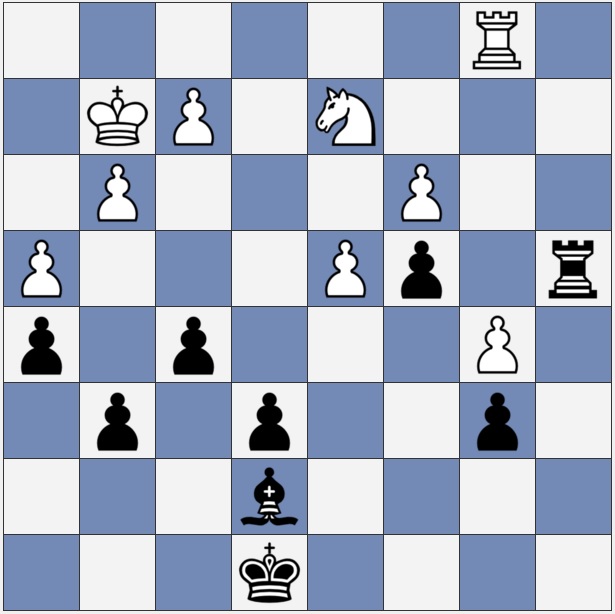
Diagram-6: White to make move number 38, in this chess end game
If Black has any advantage, it is extremely small and mostly rests on a slightly more-active rook. If both sides play well, this should be a draw.
38) f4? . . . . This is a fatal mistake, allowing a pin on the knight.
38) . . . . Ra2
39) Rd1 . . . . This was the only way to save the knight.
39) . . . . Rc2 The white pawn at c3 cannot be saved.
40) Kh3 . . . . This is a poor place for the white king.
40) . . . . Rxc3
41) Re1 Kd7
42) Ra1 Rc2 (?) Much better was probably Kd6.
43) Nf3 Bf6
44) Ra7+ Kc8 Better would have been Kd6.
45) Rf7 Rc3? Much better would have been Bd8.
46) Rxf6 Rxf3
47) Rxg6? . . . .
White should have moved Rxe6, which would have kept the white rook better involved in both offense and defense.
47) . . . . Kd7
48) Rg5 c3
.
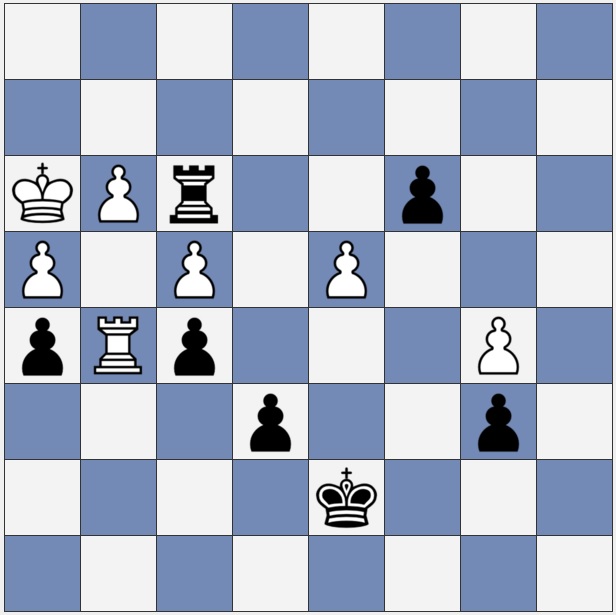
Diagram-7: White needs to play 49) Rg7+
With Black’s c-pawn only two moves from promoting to a queen, White has no time to capture that pawn at h5. The only hope for White to survive is the move 49) Rg7+ with a desperate attempt to become involved in the other side of the board (the right side).
49) Rxh5? c2
50) Rh7+ Kd6
51) Rh8 c1(Q)
52) Rd8+ Ke7
White resigned.
.
Chess Club Games in Utah
For the average chess club, you don’t necessarily need to play a whole game without any errors, if you want to win. Often, the player with the fewest mistakes, the least serious mistakes, or the next to the last mistake—that is the person who wins the game.
For senior citizens in the Salt Lake Valley of Utah, perhaps the most active chess clubs are in the senior centers in West Valley City (at the Harman recreation center) and in Sandy. If you’re at least 60, come join us at either of those locations. Come play chess, whatever your skill level, or just watch.
###
.
I’m Jonathan Whitcomb, of Murray, Utah, author of the book Beat That Kid in Chess, and I’m now offering my services as a chess coach in the Salt Lake Valley.
.
Chess tournaments directed by Whitcomb
While directing two chess tournaments in Utah recently, I devised a tiebreaker system for double round robin events . . .
.
Chess tutor in Salt Lake City area
Should the tutor play chess games with the student? I give no stock answer for chess instructors, for the best use of tutoring time depends on the precise needs of the student.
.
I teach private chess lessons, mostly in the Salt Lake Valley of Utah and generally for only $25 per lesson.
.
Chess clubs for seniors in Utah
The following game was played recently at the chess club of the Harman Senior Recreation Center in West Valley City, Utah, which is in the Salt Lake Valley.
